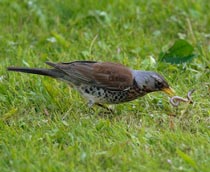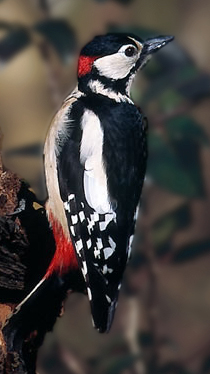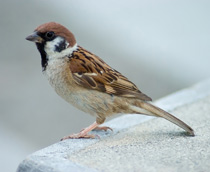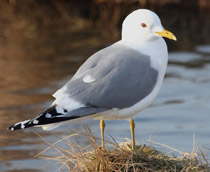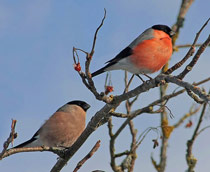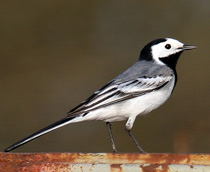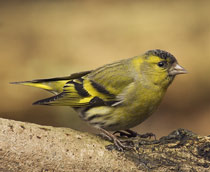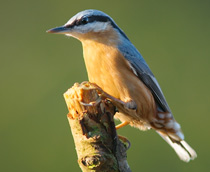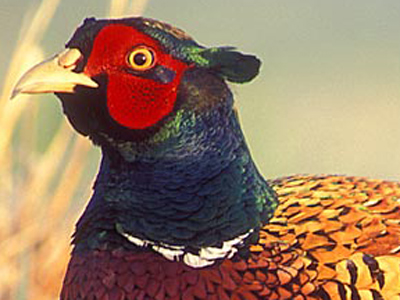
This bird was naturalized in Great Britain around the 10th century AD. Do you know what it is?
British Birds - Garden Birds 03 - Not Uncommon
This quiz contains the birds that occupy positions 21 to 30 in "The Big Garden Birdwatch" of 2011. The event is organized by the RSPB each spring and gets people all over the country reporting on the birds in their garden. Test your expertise at identifying the following garden birds. Click on the picture to enlarge the image.
To read more about the individual birds go to British Garden Birds where you will find a wealth of information on a friendly website dedicated to helping garden birdwatchers.
1.
What is the name of this bird?
Carrion Crow
European Magpie
Rook
Eurasian Jay
- Group: Crows and allies
- Binomial: Corvus frugilegus
- Order: Passeriformes
- Family: Corvidae
- Status: Resident Breeding Species
- Untidy appearance arising from the slightly peaked head and the thigh feathers, which look like baggy trousers.
- Rarely alone and so their raucous caws can become overwhelming.
2.
What is the name of this bird?
Fieldfare
Mistle Thrush
Common Redstart
European Robin
- Group: Thrushes
- Binomial: Turdus pilaris
- Order: Passeriformes
- Family: Turdidae
- Status: Winter Visitor
- They stand very upright and move forward with purposeful hops.
- Very social birds, spending the winter in flocks of anything from a dozen or two to several hundred strong.
- Diet is insects, worms and berries.
3.
What is the name of this bird?
Coal Tit
Great Spotted Woodpecker
Crested Tit
Green Woodpecker
- Group: Woodpeckers
- Binomial: Dendrocopos major
- Order: Piciformes
- Family: Picidae
- Status: Resident Breeding Species
- It has a very distinctive bouncing flight.
- The species has recently recolonized Ireland.
- Spends most of its time clinging to tree trunks and branches.
- Distinctive spring 'drumming' display.
4.
What is the name of this bird?
House Sparrow
Common Starling
Eurasian Tree Sparrow
Lapland Bunting
- Group: Sparrows
- Binomial: Passer montanus
- Order: Passeriformes
- Family: Passeridae
- Status: Resident Breeding Species
- The UK population has suffered a severe decline, estimated at 93 per cent between 1970 and 2008.
- Untidy nest usually built in a natural cavity.
- Shy and not associated with man.
5.
What is the name of this bird?
Great Cormorant
Common Gull
Little Gull
Great Black-backed Gull
- Group: Gulls
- Binomial: Larus canus
- Order: Charadriiformes
- Family: Laridae
- Status: Resident Breeding Species, Winter Visitor & Passage Migrant
- Now seen more often in towns and on housing estates in winter.
- An old historical name is sea mew.
- Global population is estimated to be about one million pairs.
6.
What is the name of this bird?
Chaffinch
Eurasian Siskin
Eurasian Bullfinch
Common Crossbill
- Group: Finches
- Binomial: Pyrrhula pyrrhula
- Order: Passeriformes
- Family: Fringillidae
- Status: Resident Breeding Species
- It is a quiet, secretive but heavily built bird.
- In keeping with its quiet nature, the song is a quiet warble.
- Its call is a piped 'phew'.
- Look for at woodland edges.
7.
What is the name of this bird?
Sand Martin
Water Pipit
Pied Wagtail
Grey Wagtail
- Group: Wagtails and Pipits
- Binomial: Motacilla alba yarrelli
- Order: Passeriformes
- Family: Motacillidae
- Status: Breeding Summer Visitor
- The most distinctive feature is its wagging tail - it never stops!
- Can be seen dashing about over lawns or car parks in search of food.
- Often gathers at dusk to form large roosts in city centres.
8.
What is the name of this bird?
Eurasian Bullfinch
Eurasian Linnet
European Goldfinch
Eurasian Siskin
- Group: Finches
- Binomial: Carduelis spinus
- Order: Passeriformes
- Family: Fringillidae
- Status: Resident Breeding Species And Winter Visitor
- It has a bounding flight pattern.
- This bird has two calls, both powerful but conflicting.
- On occasions they also issue a harsh rattling chirrup.
9.
What is the name of this bird?
Eurasian Nuthatch
Common Spoonbill
Bohemian Waxwing
Common Treecreeper
- Group: Nuthatches
- Binomial: Sitta europaea
- Order: Passeriformes
- Family: Sittidae
- Status: Resident Breeding Species
- This bird climbs up, down and around the tree trunk and branches using its powerful toes.
- Best looked for in mature woods and established parkland.
- Occasional sightings in Scotland.
10.
What is the name of this bird?
Grey Partridge
Red Grouse
Common Pheasant
Golden Pheasant
- Group: Pheasants, Partridges and Quail
- Binomial: Phasianus colchicus
- Order: Galliformes
- Family: Phasianidae
- Status: Resident Introduced Population
- The bird was naturalized in Great Britain around the 10th century AD.
- Around 30 million birds are released each year on shooting estates.
- Usually seen in the open countryside near woodland edges and copses.
**Unlimited Quizzes Await You! 🚀**
Hey there, quiz champ! 🌟 You've already tackled today's free questions.
Ready for more?
Ready for more?
🔓 Unlock UNLIMITED Quizzes and challenge yourself every day. But that's
not all...
not all...
🔥 As a Subscriber you can join our thrilling "Daily Streak" against other
quizzers. Try to win a coveted spot on our Hall of Fame Page.
quizzers. Try to win a coveted spot on our Hall of Fame Page.
Don't miss out! Join us now and keep the fun rolling. 🎉
**Unlimited Quizzes Await You! 🚀**
Hey there, quiz champ! 🌟 You've already tackled today's free questions. Ready for more?
🔓 Unlock UNLIMITED Quizzes and challenge yourself every day. But that's not all...
🔥 As a Subscriber you can join our thrilling "Daily Streak" against other quizzers. Try to win a coveted spot on our Hall of Fame Page.
Don't miss out! Join us now and keep the fun rolling. 🎉





-B.jpg)
